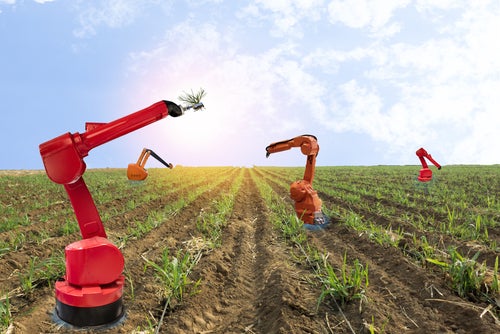The first agricultural revolution is characterized as the advent of modern farming, the second began during the industrial revolution when crop rotations were introduced, and the third revolution saw the dawn of synthetic fertilizer discovery and genetic breeding techniques, accelerating farmland productivity. The sector is now facing a multitude of complex and interdependent challenges. This comes at a time when the demands on the sector due to rapid population growth are set to accelerate, meaning a fourth revolution is needed.
The sector will also have to adapt to the impacts of climate change as, by 2030, extreme weather events such as droughts and floods will become even more common. The agricultural industry is adopting technology to overcome these challenges in what some have already called ‘The Fourth Agricultural Revolution’.
The technological agricultural revolution
The agricultural sector is increasing investment in improving farmland productivity to maximize output and satisfy changing consumer demands. This revolution is characterized by the anticipated changes brought about by novel technologies, especially the use of artificial intelligence (AI) and autonomous robots. These technologies can be used to harvest crops, pick fruit, weed, milk livestock, and autonomously apply fertilizer. These technologies are designed to help boost agricultural productivity through more efficient farming practices. For example, precision agriculture involves the application of agrochemicals and water in a prescriptive manner to minimize waste.
By 2030, improvements in rural connectivity and advancements in 5G will mean that all devices across the farming ecosystem can be connected and continually collect and store data on a farm management system for more effective operations. This will hopefully ease labor shortages, reduce the number of natural resources required, and satisfy the growing demand for agricultural products, all while adapting to the challenges of climate change.
Smarter greenhouses
Farms will become smarter as technology helps to produce more food, on less land. Smart farming incorporates precision agricultural techniques that use sensors and imaging to monitor and maximize food production. It combines the Internet of Things (IoT) and automation to create self-regulating microclimates for crops using sensors and control systems. Farms will begin to collect and monitor vast amounts of data from their operations, which will be fed into AI to automate growth.
These principles will be applied to vertical farming systems, where crops are grown in stacked, indoor farms so that more food is grown per acre. As 60% of the population will become urban by 2030, building these farms in cities will help to eliminate food miles while maintaining freshness. We are already seeing growth in this area. According to GlobalData, hiring for smart greenhouse-related roles has more than tripled from 2021. Advancements in AI have reduced the need for human intervention and investment is only going to increase as the challenges facing the sector call for more automation

US Tariffs are shifting - will you react or anticipate?
Don’t let policy changes catch you off guard. Stay proactive with real-time data and expert analysis.
By GlobalDataTaking to the skies
Agricultural drones are unmanned aerial vehicles used for yield optimization and monitoring. In 2022, drones can inspect and assess the vegetation indices of crops, which determines crop health, their harvest stage, and the nitrogen level of the soil. This information can help to prescriptively apply agricultural inputs based on the spatiotemporal requirements of crops. But already there is rapid innovation in this area.
According to GlobalData, agri-drone-related patents experienced a 14-fold increase between 2015 and 2021. By 2030, they will become autonomous and modular. Modular-based innovation will mean that drones will be able to undertake advanced crop spraying and terrain monitoring. These tasks are often unappealing to farms as they are incredibly time-consuming and the labor crisis and skills shortage will only bolster agriculture drone demand. By 2030, agricultural drones will be supported by greater rural connectivity and more localized regulation.
Challenges will remain in the fourth agricultural revolution
Although the many challenges that the sector faces have created the perfect opportunity for the development and integration of agritech, problems remain with its adoption. Farm operators need to be digitally literate and understand how to best utilize these technologies, and many farmers may be hesitant to adopt new technologies.
Farmers must become cyber-aware, as increasing the number of devices connected to farm ecosystems exposes them to cyberattacks—and our dependence on food supply chains also makes farms particularly attractive targets for cybercriminals. So, although technology may be the answer that we so desperately need to improve farming, there will still be hurdles for the future farms of 2030.








